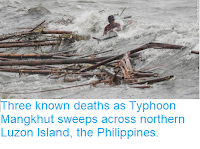Seven people have died and four more are missing following a series of landslides on southern Luzon Island in the Philippines on Friday 28 and Saturday 29 December 2018. The first event happened in the city of Legazpi in Albay Province, late on Friday, and resulted in the deaths of Mauro Alegre, 25, his wife Mia, 20, and their son Marco, 3, when a landslip destroyed their house; a further ten people were injured in the event. A further two incidents happened the next day, the first at bout 2.00 am local time, in the town of Lagonoy in Camarines Sur, when part of a hillslope collapsed onto a house, killing Charles Las Penas, 51, and his son, also Charles, 11. In a third incident a landslide in the village of Osiao in Sorsogon Province is known to have killed two people, Gilbert Desunia and Gerald Despabiladeras, with four more missing, Dominador Esquivel, Leonel Diaz, Magno Diaz, and Franklin Olavere, and another four requiring hospital treatment, Mark Diolata, John Carlo Lorill, John Robert Marcaida, and Arjay Dulpina.
The aftermath of a landslide in Legazpi City in Albay Province, the Philippines, on Friday 28 December 2018, which killed three people and injured ten more. Luence Burce Barcena/CNN Philippines.
The landslips occurred as southern Luzon was battered by rains associated with the passage of Tropical Depression Usman across the island. Landslides
are a common problem after severe weather events, as excess pore water
pressure can overcome cohesion in soil and sediments, allowing them to
flow like liquids. Approximately 90% of all landslides are caused by
heavy rainfall.
The path and strength of Tropical Depression Usman. Thick line indicates the
past path of the storm (till 6.00 pm GMT on Saturday 29 December 2018),
while the thin line indicates the predicted future path of the storm,
and the dotted circles the margin of error at 12, 24, 36, 72, 96 and 120 hours
ahead. Colour indicated the severity of the storm. Tropical Storm Risk.
Tropical depressions are caused by the warming effect of the Sun over
tropical seas. As the air warms it expands, causing a drop in air
pressure, and rises, causing air from outside the area to rush in to
replace it. If this happens over a sufficiently wide area then the
inrushing winds will be affected by centrifugal forces caused by the
Earth's rotation (the Coriolis effect). This means that winds will be
deflected clockwise in the northern hemisphere and anti-clockwise in the
southern hemisphere, eventually creating a large, rotating Tropical
Storm.
Despite the obvious danger of winds of this speed, which can physically
blow people, and other large objects, away as well as damaging buildings
and uprooting trees, the real danger from these storms comes from the
flooding they bring. Each drop millibar drop in air-pressure leads to an
approximate 1 cm rise in sea level, with big tropical storms capable of
causing a storm surge of several meters. This is always accompanied by
heavy rainfall, since warm air over the ocean leads to evaporation of
sea water, which is then carried with the storm. These combined often
lead to catastrophic flooding in areas hit by tropical storms.
See also...








